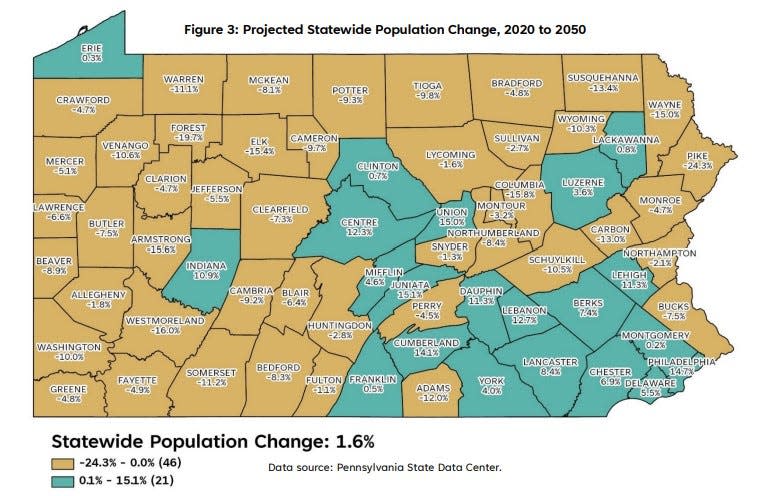Report predicts 8.9% population decline in Beaver County by 2050
A new report predicts Beaver County will face sustained population loss in the coming decades, a shift that would present far-reaching economic and social challenges for residents and policymakers.
The Center for Rural Pennsylvania, a research arm of Pennsylvania’s General Assembly, estimates that Beaver County’s population will decline by 8.9% between 2020 and 2050.
Researchers project a population of 152,940 in 2050, down from roughly 168,000 in 2020.
The report reflects a “continuing divergence of population in Pennsylvania’s rural and urban counties,” with urban areas projected to grow 4.1% and rural areas facing a 5.8% decline.

Urban areas, particularly the Philadelphia region, are expected to grow at a rate high enough to combat rural loss on a statewide level, with research suggesting Pennsylvania's overall population will grow a sluggish 1.6%.
Beaver is among a handful of counties defined by the Center as urban – based on population density – predicted to see population loss. From 2021-22, Beaver County lost a reported 1,237 people, a 0.7% decline, according to U.S. Census numbers. Allegheny County saw a 1% drop, or 12,192 people, during that same period.
Beaver County’s southwestern Pennsylvania neighbors are expected to see loss, too. The Center predicts a 1.8% decline in Allegheny County, a 6.6% decline in Lawrence County, a 7.5% decline in Butler County, a 10% decline in Washington County and a 16% decline in Westmoreland County.
What’s driving the population decline?
The Pittsburgh region, including Beaver County, has struggled with more deaths than births since the 1990s, leading to natural population loss.
Beaver County’s relative increased age over the next 30 years, paired with declining birth rates, is expected to be a significant driver of population loss. The county’s median age was 44.9 in 2022, up from 43.5 in 2009 and higher than Pennsylvania’s median age of 40.9.
“As the Baby Boomer generation continues to retire and age, the population of residents over 65 is going to sharply increase,” researchers said in the report. That means those over 65 will soon outnumber those under 20 in areas throughout the state.
Nearly 23% of Beaver County residents were over 65 years old in 2020, according to the U.S. Census. Roughly 19% were under 18 years old and 4.7% were under 5 years old.
Although negative net migration, or more people leaving than entering Beaver County, plays a role, it’s clear that attracting new residents to the county in the coming years will be crucial to reverse or slow current trends.
‘Not insurmountable:’ Consequences and solutions
A steadily declining and rapidly aging population has profound implications for Beaver County’s workforce and economy, such as a shrinking tax base and more pressure on a smaller workforce to support retired and older adults.
These trends would undoubtedly create or worsen challenges in sectors like health care, education, transportation, housing, development and more, including the need for bolstered geriatric care and less financial support for school districts.
But while the obstacles are significant, “they are not insurmountable,” researchers said.
Policy interventions and long-term planning “that incorporates the expertise of a variety of stakeholders, state and local officials, nonprofit groups, business and industry leaders, among others” will better prepare Beaver County and Pennsylvania to adapt and address projected shifts.
“The population projections will help inform medium and long-term planning at the county, regional and state levels,” said state Rep. Eddie Day Pashinski, vice chairman of the Center’s board of directors.
Notably, Pennsylvania’s retirement-age population will peak in 2035. This suggests economic adjustments to support the aging population “may require expedient action,” according to researchers.
Beaver County's elected leaders and stakeholders have long recognized the need to entice and retain younger generations, although they’re not always in agreement about how to do it.
Whether it’s championing the construction of a multi-billion-dollar plastics facility in hopes of bringing hordes of ancillary jobs, incentivizing Beaver County students with scholarships or working to bolster cultural vibrancy, recreation and accessibility, approaches and success rates remain a mixed bag.
In the coming months, the Times will further explore the potential consequences of and solutions to population trends in Beaver County across multiple sectors – including what policymakers, stakeholders and others are doing to address them.
This article originally appeared on Beaver County Times: Report predicts 8.9% population decline Beaver County by 2050

